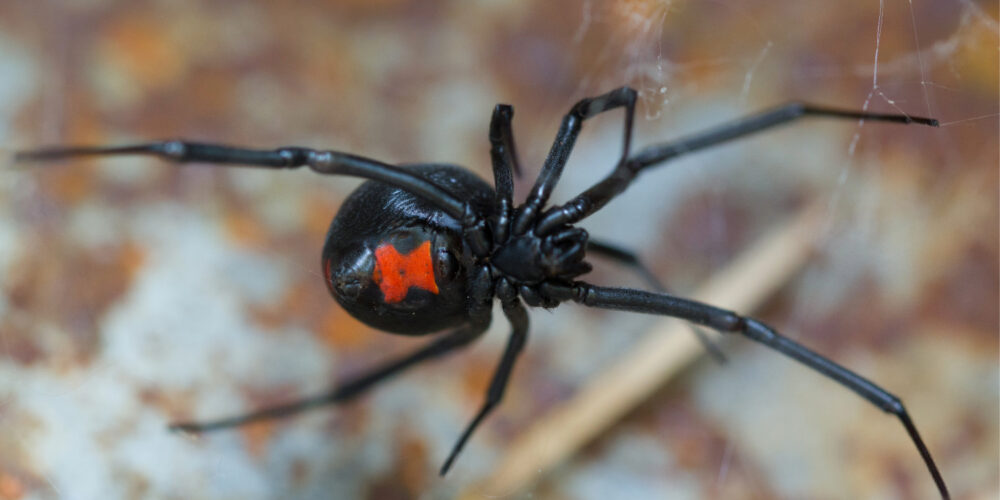Spiders are common, but some can be dangerous or alarming. Here’s what you need to know about the species we most often deal within Southern Utah:
1. Black Widow
- Appearance: Shiny black body with a red hourglass on the underside
- Behavior: Hides in dark, undisturbed areas like garages, sheds, and sprinkler boxes
- Danger: Venomous; bites can cause muscle pain, cramping, and nausea, can be especially dangerous to kids, pets, elderly, and people with underlying conditions
2. Brown Recluse
- Appearance: Light to dark brown with a violin-shaped mark on the back, often confused with the wolf spider
- Behavior: Prefers dry, dark, indoor areas like closets, attics, and boxes
- Danger: Venomous; bites can cause necrosis(decaying flesh) and require medical attention
- Habitat: Brown recluses have many look alike spiders, and are not known to exist as a breeding population in Utah, that being said, their cousins, the Desert Recluse, do live in southern Utah
3. Desert Recluse
- Appearance: Light tan to yellowish-brown, lacking the distinct violin-shaped mark; often confused with harmless spiders due to its plain coloration
- Behavior: Prefers hot, arid, outdoor environments like deserts and rocky areas; found under debris, woodpiles, or in seldom-disturbed sheds
- Danger: Venomous; bites can cause necrosis (decaying flesh) and may require medical attention
- Habitat: Found in arid regions of the southwestern U.S., including parts of Arizona, California, Nevada, and southern Utah, especially around St. George. Prefers dry, undisturbed outdoor areas such as under rocks, woodpiles, debris, and in sheds or storage areas that offer shelter from the sun.
4. Wolf Spider
- Appearance: Large, hairy, usually gray or brown with dark markings
- Behavior: Does not build webs; hunts insects on foot, often seen scurrying across floors
- Risks: Not venomous to humans, but their large size can be alarming. This species is famous for carrying its young on its back. If killed while carrying their young, the adolescent wolf spiders will spread by the dozens.
5. Hobo Spider
- Appearance: Brown with a chevron pattern on the back
- Behavior: Builds funnel-shaped webs in basements, crawlspaces, and around foundations
- Risk: Bites are debated, but they can be painful and cause localized symptoms
6. Common House Spider
- Appearance: Yellowish-brown with striped legs
- Behavior: Builds messy webs in ceiling corners, windows, and basements, common indoors in warmer months
- Danger: Harmless to humans, but webs and infestations are unsightly
7. Cellar Spider
- Appearance: Pale yellow, tan, or gray with long, thin legs and a small body; often mistaken for daddy longlegs
- Behavior: Builds irregular, messy webs in dark, damp areas like basements, crawl spaces, garages, and cellars; rarely leaves its web
- Danger: Harmless to humans; does not bite and is considered beneficial for feeding on other household pests
Why Spiders Can Be a Problem
- Venomous Threats: Some spiders can pose serious health risks with their bites
- Webs & Egg Sacs: Can quickly make a home look unclean or neglected
- Surprise Encounters: Large or fast-moving spiders (like wolf spiders) can cause fear and panic
- Indicator of Other Pests: Spiders are a symptomatic predator; If there are spiders, there is a large enough population of pests to keep them fed
Our Spider Control Method:
- Manual Web/Nest Removal: Eliminate webs, egg sacs, and hiding spots in garage, eaves, windows, fenceline, basement window wells, and structures
- Eco-friendly Perimeter Spray: Apply a non-toxic, kid and pet-safe spray around entry points and high-risk areas.
- Prevention-Focused: Treat places spiders are likely to return to like eaves, garages, basements, and crawlspaces
- Integrated Pest Management: Provide guidance to reduce future nesting

